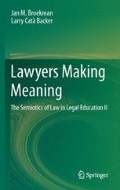Abstract
Three critical positions of legal semiotics in the waning of the CLS were highlighted as discussions within US Common Law legal scholarship. They all focus on a lawyer’s attitude: (1) one in so far as legal meanings are installed in the lives of ordinary citizens, (2) a second on a lawyer’s possible connection between a progressive standpoint in politics and semiotic knowledge or experience, whereas (3) a third made clear that legal education is inherently a process of attitude formation in view of future legal practices, so that the process itself remains in the realm of theory-formation. That particular focus shows clearly the relevance of Mr. Jourdain’s parallel situation. He did not know that he wrote prose—do lawyers know that they write and operate semiotics? All three aspects, which fascinated CLS scholars, one must conclude, are at distance from this parallel as well as the practice of law.
Access this chapter
Tax calculation will be finalised at checkout
Purchases are for personal use only
Notes
- 1.
Julia Kristeva: “L’engendrement de la formule” in: Semeiotiké. Recherches pour une Sémanalyse. Paris 1969, 278, 286.
- 2.
A good example might be the “oral argument” in a US Supreme Court, which precedes the ultimate, written judgment, printed and definitive, a surface structure in itself, comprising both the majority and dissenting opinions, applied more fully in the discussion of Citizens United, supra, Chap. 12. The oral argument could be seen as a specific, “highly stylized” discourse within legal discourse in its entirety, a specific area in which, as Chief Justice John Roberts Jr. claims: ‘justices are debating among themselves and just using the lawyers as a backboard’. It is often highlighted that oral arguments are less important than the written briefs, the spoken words carrying less weight than the written. This shows how legal texts emerge from a complex context of meanings—an emergence, which in itself seems “good for law”. See A. Liptak: “Are oral Arguments Worth Arguing About?” in The New York Times, May 6, 2012.
- 3.
Geoffry O’Brien: “Crazy Horse” in: The New York Review of Books, LIX, No. 5, p. 20.
Author information
Authors and Affiliations
Corresponding author
Rights and permissions
Copyright information
© 2013 Springer Science+Business Media Dordrecht
About this chapter
Cite this chapter
Broekman, J.M., Backer, L.C. (2013). The Legal Semiotic Modus Operandi. In: Lawyers Making Meaning. Springer, Dordrecht. https://doi.org/10.1007/978-94-007-5458-4_14
Download citation
DOI: https://doi.org/10.1007/978-94-007-5458-4_14
Published:
Publisher Name: Springer, Dordrecht
Print ISBN: 978-94-007-5457-7
Online ISBN: 978-94-007-5458-4
eBook Packages: Humanities, Social Sciences and LawLaw and Criminology (R0)

